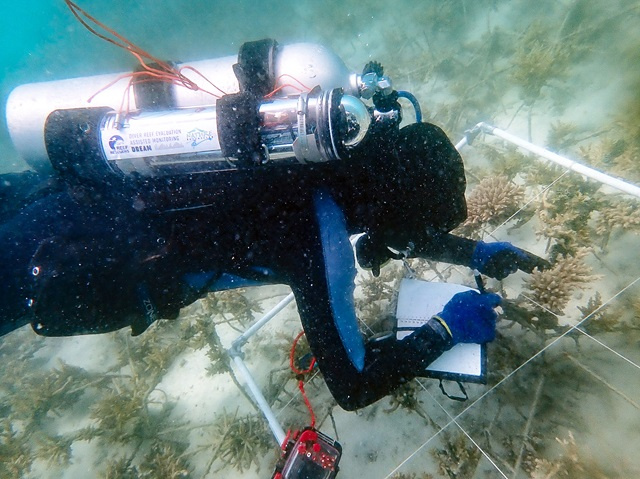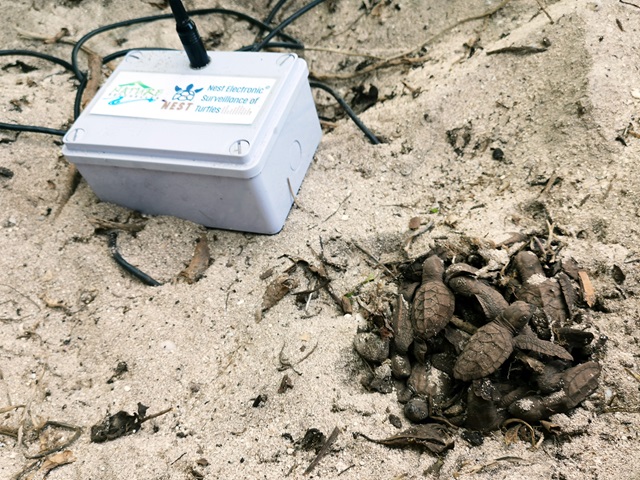Nature Seychelles pilots cutting-edge conservation technology in monitoring of turtle nests

DREAM is a fully automated sensor platform that monitors seawater parameters while autonomously collecting data during dives. (Nature Seychelles)
Nature Seychelles, in collaboration with OceanLabs Seychelles and Kingsgate Electronics, is pioneering a locally-made, cutting-edge conservation technology in the monitoring of turtle nests.
The not-for-profit environmental organisation said on Thursday that as a result of this revolutionary collaboration, two devices have been co-designed and co-produced entirely in Seychelles.
The devices are Nest Electronic Surveillance of Turtles (NEST) and Diver Reef Evaluation Assisted Monitoring (DREAM) as well as the installation of an innovative microwave internet carrier for fast and efficient transfer of large packets of data, including videos from Cousin Island Special Reserve.
"This is a significant milestone since it is the first time technology has been locally engineered in Seychelles for conservation," said Dr Nirmal Shah, chief executive of Nature Seychelles.
Shah added, "I saw a gap in our conversation toolkit and met up with a brilliant young Seychellois, Daniel Hugelmann of OceanLabs, to discuss custom-made devices tailored to our needs. These devices represent a new avenue for conservation entities and technology companies to collaborate to solve conservation challenges."
"Our collaboration with Nature Seychelles has yielded remarkable results. By combining cutting-edge technology with state-of-the-art techniques such as 3D printing, we have created tailor-made devices that meet the unique needs of Nature Seychelles' users and their specific environments," said Daniel Hugelmann, director of OceanLabs.
He added "Our iterative process of joint discussions, engineering work, prototyping, and fieldwork is a testament to our commitment to producing reliable real-world solutions. Through collaboration and hard work, we can achieve extraordinary results that benefit us all, right here in Seychelles."
 |
| NEST automatically monitors and transmits turtle nest environmental data. (Nature Seychelles) Photo License: CC-BY |
The devices are part of Nature Seychelles' Smart Island System initiative, which aims to enhance the monitoring of terrestrial and marine activities on Cousin Island. Nature Seychelles received financial backing from tech giant Huawei and the International Union for Nature Conservation's Tech4Nature project, a global partnership to scale up success in nature conservation through digital technology innovation.
The prototype's testing was completed on Cousin Island, a granitic island lying 2 km west of Praslin, the second most populated island of Seychelles. It is a nature reserve managed by Nature Seychelles and protected under Seychelles law as a special reserve. It is one of the oldest marine protected areas in Seychelles.
Both NEST and DREAM have been rigorously tested in the field over the past few months, showing their effectiveness in real-world conservation scenarios.
DREAM is a fully automated sensor platform that monitors seawater parameters while autonomously collecting data during dives while attached to a diver's air tank. The collected data, including pH, light, and dissolved oxygen levels, enhances the understanding of water quality at project sites and helps to identify threats such as algal overgrowth. The data is automatically uploaded post-dive and can be accessed through a user-friendly web interface.
The data provided is very valuable given the current bleaching alert for the western Indian Ocean.
Similarly, NEST is being used during the 2023-24 hawksbill turtle nesting season. The device automatically monitors and transmits turtle nest environmental data, including temperature, humidity, and oxygen.
Another innovation funded by Smart Island System is a 5GHz microwave link and wireless network installed by Kingsgate Electronics connecting the Nature Seychelles CORAL building on Praslin and Cousin.
It provides a robust and high bandwidth internet connection to bolster current and future conservation efforts. These include uploading data from the NEST device as well as a future project for live video streaming from wildlife cameras at strategic locations in the Special Reserve.
The collaborative partnership between these three organisations illustrates the power of local innovation in advancing conservation and paves the way for future initiatives.





